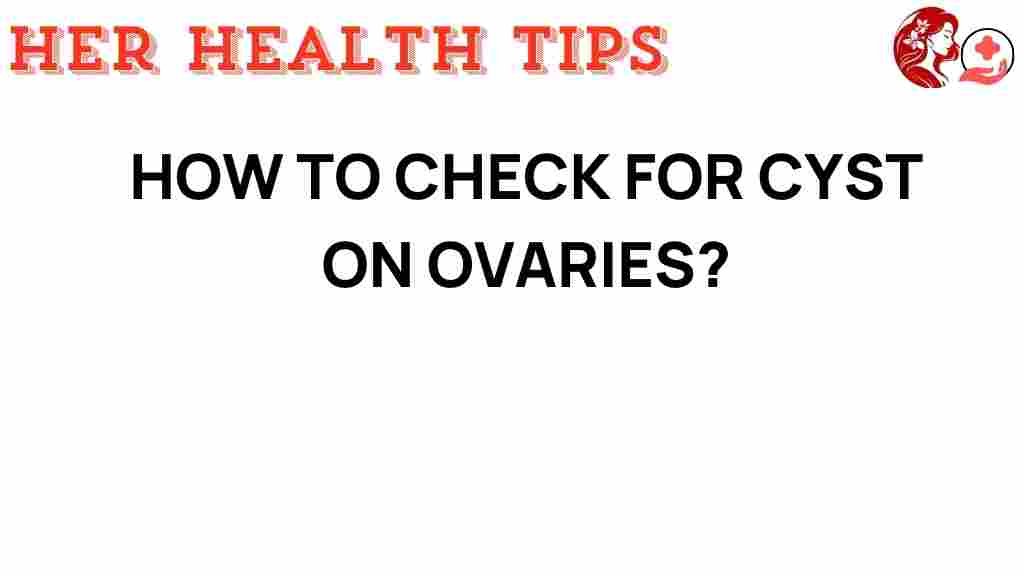Unveiling the Mystery: How to Check for Ovarian Cysts Effectively
Ovarian cysts are fluid-filled sacs that can develop on the ovaries, and they are a common concern in women’s health. Many women may experience symptoms related to ovarian cysts at some point in their lives. Understanding how to check for ovarian cysts effectively is crucial for early diagnosis and treatment.
In this article, we will explore the symptoms, diagnosis, and treatment of ovarian cysts, as well as the importance of awareness and prevention. We will guide you through the process of recognizing potential cysts and the necessary steps to take for a thorough evaluation.
Understanding Ovarian Cysts
Ovarian cysts are typically benign and can form during the menstrual cycle. However, some cysts can cause complications and may require medical attention. It’s essential to be aware of the symptoms associated with ovarian cysts to seek proper diagnosis and treatment.
Symptoms of Ovarian Cysts
Many women with ovarian cysts experience little to no symptoms. However, when symptoms do occur, they may include:
- Pelvic pain, which may occur on one side
- Menstrual irregularities, including missed periods
- Abdominal bloating or swelling
- Difficulty emptying the bladder or frequent urination
- Changes in bowel habits
- Pain during intercourse
- Breast tenderness
If you experience any of these symptoms, it is important to consult with a healthcare provider for further evaluation.
Diagnosis of Ovarian Cysts
Diagnosis of ovarian cysts typically involves a combination of a pelvic exam, imaging tests, and possibly blood tests. Here’s a step-by-step process for how healthcare professionals check for ovarian cysts:
Step 1: Pelvic Exam
A pelvic exam is often the first step in diagnosing ovarian cysts. During this examination, your doctor will:
- Check for any abnormalities in the reproductive organs
- Assess the size and shape of the ovaries
- Look for signs of tenderness or swelling
This physical assessment can provide preliminary insights into the presence of ovarian cysts.
Step 2: Ultrasound Imaging
If a cyst is suspected during the pelvic exam, your doctor may recommend an ultrasound, which is a key diagnostic tool. There are two types of ultrasounds that may be performed:
- Transabdominal ultrasound: This is performed by placing a transducer on the abdomen to visualize the ovaries.
- Transvaginal ultrasound: This involves inserting a transducer into the vagina for a closer view of the ovaries.
Ultrasound imaging helps determine the size, shape, and type of cyst present, allowing for better assessment of whether it requires treatment.
Step 3: Blood Tests
In some cases, blood tests may be ordered to check for elevated levels of certain markers, such as the CA-125 test, which can indicate the presence of ovarian cancer. This is particularly important for women over 50 or those with a family history of ovarian cancer.
Step 4: Follow-Up and Monitoring
Depending on the results of the pelvic exam, ultrasound, and blood tests, your healthcare provider may recommend follow-up ultrasounds to monitor the cyst over time. Many ovarian cysts resolve on their own and do not require treatment.
Common Types of Ovarian Cysts
Understanding the types of ovarian cysts can also aid in awareness and prevention:
- Functional cysts: These are the most common and occur during the menstrual cycle.
- Dermoid cysts: These can contain hair, fat, and other tissues.
- Cystadenomas: These develop from the cells on the outer surface of the ovary and can be filled with fluid or mucous.
- Endometriomas: These are associated with endometriosis and are formed from endometrial tissue.
Treatment for Ovarian Cysts
The treatment for ovarian cysts depends on several factors, including the type of cyst, its size, and the symptoms it causes. Here are the common treatment options:
Watchful Waiting
If the cyst is small and asymptomatic, your doctor may recommend a watchful waiting approach. This means monitoring the cyst over time with follow-up ultrasounds to see if it resolves on its own.
Medication
Hormonal contraceptives, such as birth control pills, can help regulate the menstrual cycle and may prevent the formation of new cysts. However, this does not eliminate existing cysts.
Surgery
If a cyst is large, persistent, or causes severe symptoms, surgical intervention may be necessary. The types of surgery include:
- Laparoscopy: A minimally invasive procedure used to remove the cyst.
- Laparotomy: An open surgical procedure for larger cysts or when cancer is suspected.
When to Seek Medical Attention
It’s essential to seek medical attention if you experience:
- Severe pelvic pain
- Sudden onset of abdominal swelling
- Fever or vomiting
- Difficulty breathing
These symptoms may indicate a ruptured cyst or other complications that require immediate care.
Raising Awareness and Prevention
Awareness of ovarian cysts is crucial for women’s health. Here are some tips for prevention and awareness:
- Regular check-ups: Schedule routine pelvic exams to monitor your reproductive health.
- Educate yourself: Learn about the signs and symptoms of ovarian cysts.
- Maintain a healthy lifestyle: A balanced diet and regular exercise can help regulate hormones and reduce the risk of cyst formation.
- Manage stress: Stress can impact hormonal balance, so consider stress-reduction techniques such as yoga or meditation.
For further information on women’s health, you can visit WomensHealth.gov.
Conclusion
Ovarian cysts are a common issue in women’s health, and understanding how to check for them effectively is vital for early diagnosis and treatment. By recognizing the symptoms, undergoing appropriate diagnostic tests, and being proactive about your health, you can manage ovarian cysts effectively.
Always consult with a healthcare provider if you suspect you may have ovarian cysts or if you experience any concerning symptoms. Awareness and education are key factors in prevention and ensuring your overall reproductive health.
Remember, knowledge is power—stay informed about your body and seek help when necessary!
For further reading on ovarian cysts and related conditions, check out our comprehensive guide.
This article is in the category Reproductive and created by HerHealthTips Team
